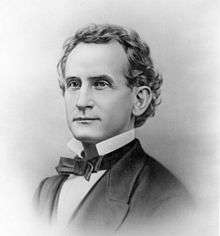John W. Dawson
| John W. Dawson | |
|---|---|
 John W. Dawson | |
| Governor of Utah Territory | |
|
In office 1861–1861 | |
| Preceded by | Alfred Cumming |
| Succeeded by | Stephen S. Harding |
| Personal details | |
| Born |
October 21, 1820 Cambridge, Indiana, United States |
| Died | September 10, 1877 (aged 56) |
| Resting place | Lindenwood Cemetery, Fort Wayne, Indiana |
| Citizenship | American |
| Political party | Republican |
| Other political affiliations | Originally Democrat |
John W. Dawson (October 21, 1820 – September 10, 1877) was Governor of Utah Territory in 1861.
Born on October 21, 1820, in Cambridge, Indiana he was a lawyer, a farmer and a newspaper editor before he entered politics. He eventually became the Governor of Utah.
Newspaper career
Dawson, along with T.N. Hood, leased George W. Wood's interest in the Fort Wayne Times and People's Press for one year, starting on September 7, 1953.[1] They changed the name to the Fort Wayne Times and continued to publish until Hood sold his interest to Dawson and Wood. Wood retired in 1854, leaving Dawson in charge of the paper. In 1854, the Times had a decidedly Anti-Nebraska sentiment while Thomas Tigar's Fort Wayne Sentinel had the opposite attitude.[2] Dawson's political issues included being anti-abolition, temperance, free public schools, and various Know-nothing/Fusion Party/People's Party issues.[3] The paper continued in various forms until 1865, when Dawson sold the paper to Henry Dills and Isaac W. Campbell. In 1866, the paper merged with the Fort Wayne Sentinel.[4]
Political career
Dawson ran unsuccessfully for a seat in the Indiana House of Representatives in 1854, Secretary of State of Indiana in 1856, and United States Congress in 1858. He started as a Democrat, but later became a Republican.
Utah Governor
Abraham Lincoln named him governor of Utah Territory in 1861, but he left the territory and his post as governor after only three weeks due to tensions with the Mormon residents. Dawson allegedly made "grossly improper proposals" to the Mormon widow Albina Merrill Williams, who responded by thrashing him with a fire shovel.
Taking a mail coach eastward, he arrived at Ephraim Hanks' Pony Express station at Mountain Dell, Utah. There, Hanks assured Dawson he was now safe. However a group of young Mormon vigilantes named Jason Luce, Martin "Matt" Luce, Wilford Luce, Wood Reynolds, Moroni Clawson, Lot Hungtington, and Isaac Neibaur followed the retreating governor, and during a night of drinking, they plundered the governor's baggage, and attacked him, beating and kicking Dawson about the head, chest, and groin (and allegedly castrating one of his testicles). The thugs later claimed they were acting under direct orders of the Salt Lake Police Chief. Four of the youths were captured but the other three were gunned down trying to escape from police and sheriffs.[5][6][7]
Later career
Dawson later became famous as the first biographer of John Chapman, the legendary Johnny Appleseed. Dawson's 1871 article in the Fort Wayne News Sentinel of October 21 and 23 about Dawson's childhood friend is still considered the main source for biographical information on Chapman.
He died on September 10, 1877 and was interred at Lindenwood Cemetery in Fort Wayne, Indiana.[8]
See also
- Runaway Officials of 1851 - previous Utah Territory office holders who also literally ran away from their official duties.
Notes
- ↑ History of Allen County, Indiana. Chicago: Kingman Brothers. 1880. p. 104. Retrieved 15 April 2016.
- ↑ Seigel, Peggy. "The Fort WayneStandard: A Reform Newspaper in the 1850s Storm". https://scholarworks.iu.edu Volume 97, Issue 3, September 2001 > Seigel. Indiana Magazine of History.
Fort Wayne already had two viable newspapers in 1854, the antislavery Fort Wayne Times and the Democratic Fort Wayne Sentinel. The Times, published by John W. Dawson, was staunchly opposed to the Kansas-Nebraska Act, while the Sentinel, published by Thomas Tigar, endorsed it as the key to saving the union. Although the Times was antislavery, it was also strongly opposed to abolitionism and characterized abolitionists as "fanatical" and "impractical."
External link in|website=(help) - ↑ Long, E. B. (1981). The Saints and the Union: Utah Territory During the Civil War (first paperback edition 2001 ed.). Urbana and Chicago: University of Illinois Press. p. 39. ISBN 0-252-07011-9.
while conservative on the slavery issue and anti-abolitionist, Dawson was strongly for temperence, for free public schools, ... noticeable Know-Nothing overtone...candidate for the legislature on the PEople's party ticket...candidate for... People's Party or Fusion ticket
- ↑ History of Allen County, Indiana. Chicago: Kingman Brothers. 1880. p. 104. Retrieved 15 April 2016.
- ↑ "Governor Dawson's Statement", Deseret News, January 22, 1862, pp. 2
- ↑ "Exciting and Terrifying Occurrences", Deseret News, January 22, 1862, pp. 5
- ↑ "Third Governor Was Run Out of Utah After 3 Weeks", Will Bagley, Salt Lake Tribune, December 30, 2001, p. B1.
- ↑ The Political Graveyard: Index to Politicians: Dawson
| Political offices | ||
|---|---|---|
| Preceded by Alfred Cumming |
Governor of Utah Territory 1861 |
Succeeded by Stephen S. Harding |
.svg.png)